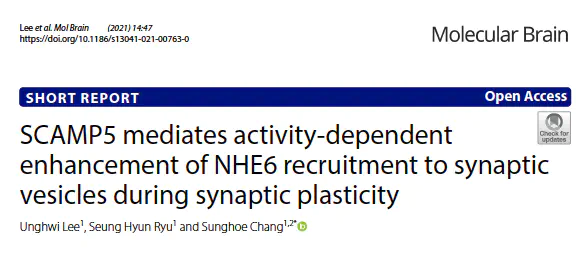SCAMP5 mediates activity-dependent enhancement of NHE6 recruitment to synaptic vesicles during synaptic plasticity
 Image credit: BMC
Image credit: BMC
Abstract
Na+(K+)/H+ exchanger 6 (NHE6) on synaptic vesicle (SV) is critical for the presynaptic regulation of quantal size at the glutamatergic synapses by converting the chemical gradient (ΔpH) into membrane potential (Δψ) across the SV membrane. We recently found that NHE6 directly interacts with secretory carrier membrane protein 5 (SCAMP5), and SCAMP5-dependent recruitment of NHE6 to SVs controls the strength of synaptic transmission by modulation of quantal size of glutamate release at rest. It is, however, unknown whether NHE6 recruitment by SCAMP5 plays a role during synaptic plasticity. Here, we found that the number of NHE6-positive presynaptic boutons was significantly increased by the chemical long-term potentiation (cLTP). Since cLTP involves new synapse formation, our results indicated that NHE6 was recruited not only to the existing presynaptic boutons but also to the newly formed presynaptic boutons. Knock down of SCAMP5 completely abrogated the enhancement of NHE6 recruitment by cLTP. Interestingly, despite an increase in the number of NHE6-positive boutons by cLTP, the quantal size of glutamate release at the presynaptic terminals remained unaltered. Together with our recent results, our findings indicate that SCAMP5-dependent recruitment of NHE6 plays a critical role in manifesting presynaptic efficacy not only at rest but also during synaptic plasticity. Since both are autism candidate genes, reduced presynaptic efficacy by interfering with their interaction may underlie the molecular mechanism of synaptic dysfunction observed in autism.
Supplementary notes can be added here, including code, math, and images.